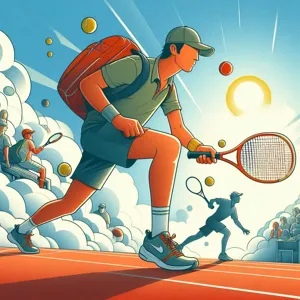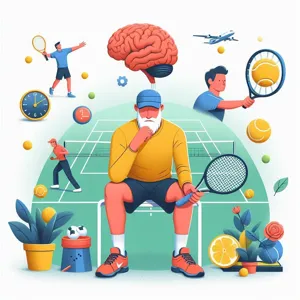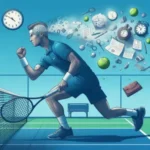In the world of tennis, consistency is the golden key that unlocks peak performance and elevates your game from average to exceptional.
Whether you’re a budding amateur or a seasoned player, mastering the art of consistent play can be the defining factor in your success on the court. It’s not just about hitting powerful serves or executing flawless backhands; it’s about developing a reliable rhythm that allows you to respond to every challenge with confidence and precision. In this comprehensive guide, we’ll delve into proven strategies that will help you cultivate consistency in your game, from enhancing your mental focus and refining your technique to establishing effective practice routines. Join us as we explore the essential elements that will not only boost your performance but also transform your overall enjoyment of this dynamic sport. Get ready to take your tennis skills to new heights!
1. Understanding the Importance of Consistency in Tennis

In the world of tennis, consistency is more than just a buzzword; it’s the bedrock of a successful game. Unlike the fleeting brilliance of a powerful serve or an impressive volley, consistency is what keeps players on the court and in control of the match. Every seasoned player knows that a single errant shot can shift the momentum, while a steady stream of reliable returns can frustrate opponents and lead to victory.
At its core, consistency in tennis refers to the ability to execute shots with precision and reliability, minimizing unforced errors while maintaining a high level of performance throughout the match. Whether you’re a beginner just starting or an experienced player aiming to refine your skills, understanding the importance of consistency can dramatically transform your gameplay.
Imagine you’re in the heat of a match, the score is tight, and every point counts. It’s during these crucial moments that players who prioritize consistency shine. They possess the mental fortitude to stay focused, relying on their training to deliver accurate serves, groundstrokes, and volleys time and again. This methodical approach not only enhances their own performance but also puts psychological pressure on their opponents, who may become increasingly frustrated by their inability to break through a consistent defense.
Moreover, consistency extends beyond just shot-making; it encompasses various aspects of the game, including footwork, shot selection, and even mental resilience. A consistent player demonstrates excellent court coverage, allowing them to position themselves optimally for each shot, and makes calculated decisions that align with their strengths. By honing these skills, you create a foundation that enables you to endure the ebbs and flows of a match, ultimately leading to improved results.
In essence, grasping the significance of consistency in tennis isn’t merely about enhancing your technical skills; it’s a holistic approach to the game. As we delve deeper into the strategies that can help you master consistency, remember that cultivating this essential quality will not only elevate your game but also enrich your overall experience on the court. With practice and dedication, you can transform your playstyle, ensuring that every match feels more controlled, focused, and rewarding.
2. The Mindset Shift: Embracing the Journey
In the world of tennis, success is not solely determined by physical prowess or technical skills; it begins with a powerful mindset. Embracing the journey of improvement is essential for any aspiring player. This mindset shift involves seeing every practice session, every match, and every setback as part of your evolving story rather than as isolated events.
When you adopt a journey-focused mentality, you cultivate resilience. Each time you step onto the court, remind yourself that each experience, be it a win or a loss, is a stepping stone toward mastery. Celebrate small victories—like perfecting your serve or improving your footwork—and recognize that progress is often nonlinear. Some days will feel like leaps forward, while others may seem stagnated. Embracing this ebb and flow helps to mitigate frustration and fosters a sense of patience and dedication.
Furthermore, by shifting your focus from immediate results to long-term growth, you allow yourself the freedom to experiment and learn from mistakes. Instead of fearing failure, you start to view challenges as opportunities to develop your skills and understanding of the game. This perspective not only improves your technical abilities but also enhances your enjoyment of the sport.
Incorporate mindfulness practices into your routine, such as visualization and positive affirmations, to reinforce this mindset. Picture yourself achieving your goals and reminding yourself that every great player has faced obstacles on their path to greatness. As you embrace the journey, you’ll find yourself more motivated, adaptable, and ultimately, equipped to elevate your game to the next level. Remember, tennis is as much about the mind as it is about the body; nurture your mental resilience, and watch your performance soar.
3. Developing a Solid Practice Routine

Developing a solid practice routine is the cornerstone of elevating your tennis game and mastering consistency on the court. Just like any other sport, tennis requires not only skill but also strategic repetition. A well-structured practice regimen allows you to hone your technique, build muscle memory, and cultivate the mental fortitude necessary for competitive play.
Start by assessing your current skill level and identifying specific areas for improvement. Whether it’s your serve, backhand, footwork, or overall match strategy, pinpointing your focus will help you create a targeted routine. Aim to practice at least three to four times a week, dedicating time to both drills and match play. For example, allocate one session a week for serving practice, emphasizing placement and power, while another can be reserved for groundstrokes, focusing on consistency and depth.
Incorporating variety into your practice is essential to keep motivation high and avoid monotony. Mix in drills that challenge your foot speed, agility, and reaction time, such as shadow swings or cone drills. Don’t forget the importance of live ball drills where you can practice rallying with a partner, simulating real match conditions. This not only sharpens your skills but also allows for learning to adapt to different styles of play.
Another key aspect of a solid practice routine is setting clear, achievable goals for each session. Perhaps you aim to hit 80% of your first serves in or maintain a rally of ten shots without errors. Tracking your progress not only provides motivation but also a sense of accomplishment, fostering a growth mindset.
Lastly, remember that mental conditioning is equally important. Include time for visualization techniques, where you mentally rehearse successful shots and match scenarios. This mental practice can greatly enhance your confidence and focus during actual games.
By committing to a solid practice routine that incorporates specific skills, variety, goal-setting, and mental training, you will not only improve your technical abilities but also develop the consistency needed to perform at your best when it matters most. Consistency isn’t just about repeating actions; it’s about refining them until they become second nature, allowing you to dominate the court with each swing of the racket.
4. Drills to Enhance Consistency in Your Shots
### 4. Drills to Enhance Consistency in Your Shots
Mastering consistency in your tennis game is not just about practicing harder; it’s about practicing smarter. Incorporating targeted drills into your training regimen can significantly enhance your shot consistency, allowing you to stay composed under pressure and keep your opponents on their toes. Here are some effective drills that can help you refine your technique and develop a more reliable game.
**1. The Wall Drill:** Find a wall and hit against it, focusing on your form and follow-through. Start by hitting the ball with a forehand, ensuring your grip and stance are correct. After a few successful hits, switch to your backhand. Keep your eye on the ball and try to maintain a steady rhythm. As you become more comfortable, challenge yourself by varying your pace, spin, and placement. This drill not only helps improve shot consistency but also fine-tunes your reflexes.
**2. Target Practice:** Set up targets on the court, using cones or other markers to designate specific areas. As you rally with a partner, aim for these targets to develop your accuracy. Start with larger targets and gradually decrease their size as your consistency improves. This drill emphasizes precision and encourages you to focus on placement rather than power, which is crucial for maintaining consistency during matches.
**3. The Two-Ball Drill:** This drill is perfect for honing both your forehand and backhand shots under pressure. Have a partner feed you two balls in quick succession—one to your forehand side and the other to your backhand. The goal is to maintain a steady rhythm while hitting both shots with consistent depth and placement. This drill simulates match conditions, helping you practice maintaining your composure and consistency when faced with rapid exchanges.
**4. Crosscourt Rally:** Engage in a crosscourt rally with a partner, focusing on keeping the ball in play for an extended period. This drill encourages consistency by requiring you to hit the ball with proper technique while also promoting patience. Set a goal for the number of consecutive shots you want to achieve before making an error. As you improve, increase the distance between you and your partner or introduce a time limit to keep the drill challenging.
**5. Serve and Return Consistency:** Serving and returning effectively are crucial components of a consistent game. Practice your serve by targeting specific areas of the service box, ensuring that you are not just focusing on power but also on accuracy and placement. Once you’ve worked on your serves, switch roles and practice returning different types of serves. Aim to keep the rally going by focusing on making solid contact with the ball and placing your shots strategically.
By incorporating these drills into your practice routine, you’ll cultivate a more reliable game that can withstand the pressures of competition. Remember, consistency is built over time, so be patient with your progress and celebrate the small victories along the way. With dedication and focused practice, you’ll find yourself elevating your game and enjoying greater success on the court.
5. The Role of Footwork in Maintaining Consistency

Footwork is often the unsung hero of a successful tennis game, yet it plays a pivotal role in maintaining consistency on the court. When we talk about consistency, we refer to the ability to deliver reliable shots, maintain rallies, and ultimately control the pace and rhythm of the game. Good footwork is the foundation that allows players to achieve this.
Imagine stepping onto the court, your feet light and agile, ready to respond to the opponent’s every move. With proper footwork, you can position yourself optimally for each shot, ensuring you’re balanced and prepared to strike the ball with precision. This positioning not only enhances your ability to hit powerful shots but also minimizes the risk of errors, allowing you to maintain a steady flow throughout the match.
To develop effective footwork, focus on a few key elements: agility, speed, and anticipation. Agility drills—such as ladder exercises and cone sprints—can sharpen your quickness, enabling you to change direction swiftly. Speed is equally crucial; incorporating sprinting exercises into your training routine can improve your overall movement on the court. Perhaps most importantly, work on your anticipation skills. By learning to read your opponent’s body language and shot preparation, you can get a head start on your footwork, positioning yourself in the ideal spot to execute your next shot.
Consistency isn’t just about hitting the ball; it’s about being in the right place at the right time, and that’s where footwork shines. By honing your movement skills, you create a solid base from which to build your game. As you improve your footwork, you’ll find that your overall performance significantly enhances, with more reliable shots and increased confidence in your abilities. So, lace up those shoes, hit the court, and let your feet do the talking—because mastering footwork is a crucial step toward elevating your tennis game to new heights.
6. Mastering the Basics: Grip, Stance, and Swing
Mastering the Basics: Grip, Stance, and Swing
At the heart of every successful tennis player lies a solid foundation built on mastering the basics: grip, stance, and swing. These fundamental elements are not just technicalities; they are the building blocks that can elevate your game to new heights.
**Grip** is your first point of contact with the racket, and it greatly influences your control and power. Whether you prefer the Eastern grip for a classic feel or the Western grip for a modern topspin, finding the right grip for you is essential. Take the time to experiment with different grips during practice sessions. Feel how each one affects the trajectory and spin of the ball. A confident grip will boost your confidence on the court, allowing you to focus on strategy rather than worrying about how to hold your racket.
Next, let’s talk about **stance**. Your stance sets the stage for every shot you make. A solid, balanced stance not only provides stability but also allows for quick movement in any direction. Whether you’re preparing for a forehand, backhand, or serve, ensure your feet are shoulder-width apart and your knees are slightly bent. This athletic position enables you to react swiftly to your opponent’s shots and maintain your balance during swings. Practice transitioning between different stances—open, closed, and semi-open—so you can adapt to various game situations seamlessly.
Finally, we must consider the **swing**. Your swing is where the magic happens, translating your preparation into powerful shots. Focus on the fluidity and mechanics of your swing, from the take-back to the follow-through. Pay attention to your timing and rhythm; a well-timed swing can generate impressive power and precision. Use drills to isolate your swing mechanics—consider shadow swings without a ball or practicing against a wall to reinforce good habits. Remember, consistency in your swing will lead to consistency in your game.
Incorporating drills that focus on these three components into your training routine is vital. Set aside specific practice sessions dedicated solely to grip, stance, and swing refinement. Over time, these repetitions will begin to feel second nature, allowing you to play with greater confidence and consistency. By mastering the basics, you’ll create a strong foundation that enhances your overall performance and keeps you competitive on the court. Embrace these fundamentals, and watch your game transform!
7. Incorporating Mental Training Techniques

In the world of tennis, mastering the physical aspects of the game is essential, but it’s the mental game that often distinguishes the great players from the good ones. Incorporating mental training techniques can profoundly elevate your performance on the court, allowing you to maintain focus, manage pressure, and enhance your overall game strategy.
Start by integrating visualization exercises into your practice routine. This technique involves mentally rehearsing your strokes, footwork, and match scenarios before you even step onto the court. Imagine yourself executing perfect serves or rallying with precision against your opponent. Research has shown that visualizing success can create neural pathways similar to actual practice, bolstering your confidence and preparing your mind for real match situations.
Another effective mental training technique is mindfulness meditation. By dedicating just a few minutes each day to mindfulness, you can cultivate a sense of calm and presence that translates to improved focus during matches. Mindfulness helps you become more aware of your thoughts and emotions, allowing you to remain centered and composed, even when the pressure mounts. This heightened awareness can be a game-changer when facing critical points or challenging opponents.
Additionally, consider setting specific, achievable goals for both your practice sessions and matches. Developing a clear set of objectives not only gives you something to strive for but also fosters a sense of accountability. Break down your larger goals into smaller, manageable tasks that you can focus on during each practice—whether it’s improving your backhand, increasing your serve speed, or enhancing your footwork. This structured approach not only keeps you motivated but also allows you to track your progress over time.
Finally, embrace the power of positive self-talk. The way you speak to yourself can greatly impact your mindset and performance. Replace negative thoughts with affirmations that reinforce your abilities and potential. Phrases like “I am strong,” “I am capable,” and “I can handle pressure” can help shift your mental state toward a more empowering and positive perspective.
Incorporating these mental training techniques into your routine will not only enhance your on-court performance but also foster a resilient mindset that can adapt to the ups and downs of the game. As you focus on strengthening your mental game, you’ll find that consistency and confidence follow, propelling you toward new heights in your tennis journey.
8. Analyzing Your Game: Video Feedback and Self-Assessment
### 8. Analyzing Your Game: Video Feedback and Self-Assessment
In the quest for tennis excellence, one of the most powerful tools at your disposal is the ability to analyze your game through video feedback and self-assessment. Imagine stepping onto the court equipped not just with your racquet, but with a keen eye for improvement. Recording your practice sessions or matches can provide invaluable insights that are often missed in the heat of play.
Start by capturing footage of various aspects of your game: your serve, groundstrokes, footwork, and even your positioning during rallies. Watching these recordings can be a revelation. You may notice habits that are holding you back, such as an inconsistent toss during your serve, or a tendency to stand too far behind the baseline. These visual cues offer a tangible way to identify strengths and weaknesses, allowing you to fine-tune your technique with a level of precision that is hard to achieve through mere observation.
Self-assessment goes hand-in-hand with video analysis. After reviewing your footage, take the time to reflect on your performance. What did you execute well? Where did you struggle? Consider keeping a journal to track your observations and set specific goals for your next practice. This reflective process not only enhances your awareness on the court but also fosters a mindset geared towards growth and improvement.
Additionally, sharing your videos with a coach or a trusted training partner can provide a fresh perspective. They may spot areas for improvement that you might overlook or offer constructive criticism that can elevate your game to new heights. Engaging in discussions about your performance can also lead to new strategies or drills that target your specific needs.
Combining video feedback with self-assessment is a game-changer for players of all levels. It empowers you to take control of your development, ensuring that each hour you spend on the court is not just time invested, but a step toward mastering consistency and elevating your overall performance. So, grab your camera, hit record, and embark on a journey of self-discovery that could redefine your approach to the game.
9. Setting Realistic Goals for Improvement
Setting realistic goals for improvement is a cornerstone of mastering consistency in tennis. Whether you’re a budding beginner or an experienced player aiming to refine your skills, understanding the importance of achievable objectives can make a significant difference in your performance and motivation.
Start by evaluating your current skill level and identifying specific areas you wish to improve. This could range from enhancing your serve speed, perfecting your backhand, or even increasing your overall stamina on the court. Once you have pinpointed these areas, break them down into smaller, manageable goals. For instance, instead of setting an overarching goal like “become a better player,” aim for something like “increase my first serve percentage by 10% over the next month.”
This method not only provides you with clear targets but allows you to track your progress in a structured manner. Celebrate small victories along the way—whether it’s successfully executing a new drill or noticing an uptick in your match performance. These moments of achievement will fuel your motivation and keep you engaged in the process.
Moreover, remember to be adaptable. If you find that certain goals are consistently out of reach, don’t hesitate to reassess and adjust them. Flexibility is key; it enables you to stay focused and committed without feeling overwhelmed or discouraged.
Setting realistic goals creates a roadmap for your improvement journey, ensuring that each step you take is purposeful and rewarding. This approach not only enhances your skills on the court but cultivates a mindset of resilience and determination—essential qualities for any aspiring tennis player. With each small goal you achieve, you’ll find yourself closer to mastering consistency and elevating your game to new heights.
10. Staying Physically Fit: Conditioning for Tennis
Staying physically fit is a cornerstone of any successful tennis game, and conditioning for tennis should be approached with both strategy and dedication. Tennis is a demanding sport that requires a unique blend of strength, agility, endurance, and flexibility. To elevate your game, it’s essential to develop a conditioning routine that caters specifically to these needs.
Start with cardiovascular training, as it enhances your stamina and allows you to maintain peak performance throughout long matches. Activities like running, swimming, or cycling can build your aerobic capacity, giving you the endurance to chase down every ball until the final point. Incorporating interval training can also be highly effective; short bursts of high-intensity exercise mimic the quick, explosive movements required on the court.
Strength training is equally crucial. Focus on exercises that target your core, legs, and upper body to build the power necessary for strong serves and groundstrokes. Weightlifting, resistance bands, and bodyweight exercises like lunges, squats, and planks can help enhance your muscle strength and stability. Pay special attention to your forearms and shoulders, as these areas are pivotal for racket control and reducing the risk of injury.
Flexibility and mobility exercises should not be overlooked. A well-rounded stretching routine will improve your range of motion, allowing for greater reach and better shot execution. Yoga or dynamic stretching can help maintain flexibility, which is vital for preventing injuries and ensuring you can perform at your best, especially in high-pressure situations.
Lastly, don’t forget the importance of recovery. Your body needs time to heal and rebuild, so make sure to include rest days in your training regimen. Proper nutrition and hydration also play a critical role in your overall fitness level and performance. Fueling your body with the right nutrients will ensure you have the energy and endurance to stay competitive on the court.
By prioritizing physical fitness and conditioning tailored for tennis, you’ll not only enhance your performance but also increase your enjoyment of the game. The road to mastery is paved with consistent effort; stay dedicated to your conditioning, and watch as your skills and confidence flourish on the court.
11. Strategies for Managing Pressure During Matches
In the high-stakes world of tennis, the ability to manage pressure during matches can often be the defining factor between victory and defeat. Whether you’re facing a fierce opponent in a local tournament or competing on a grand stage, the mental game is just as crucial as your physical skills. Here are some effective strategies to help you stay calm, focused, and composed when the heat is on.
**1. Breathing Techniques:** One of the simplest yet most effective ways to manage pressure is through controlled breathing. When faced with a crucial point or tight game, take a moment to inhale deeply through your nose, allowing your diaphragm to fill with air, and then exhale slowly through your mouth. This technique not only helps reduce anxiety but also aids in maintaining your focus and rhythm throughout the match.
**2. Visualization:** Before stepping onto the court, take some time to visualize your performance. Picture yourself executing successful serves, making precise shots, and celebrating your victories. This mental rehearsal can help boost your confidence and create a positive mindset that prepares you to handle pressure when it arises.
**3. Establish a Routine:** Developing a consistent pre-serve or pre-point routine can provide a sense of familiarity and control when the match intensity rises. Whether it’s bouncing the ball a certain number of times before serving or taking a moment to wipe your brow, these small rituals can ground you in the moment, helping to alleviate nerves and maintain focus.
**4. Embrace the Challenge:** Shifting your perspective on pressure can transform how you experience it. Instead of viewing it as a burden, consider it an opportunity to showcase your skills. Embrace the challenge of performing under pressure, and remind yourself that every match is a chance to grow and improve, regardless of the outcome.
**5. Focus on the Process, Not the Outcome:** During a match, it’s easy to get caught up in the score, but this can lead to unnecessary stress. Instead, direct your attention to your current strategy and the steps you need to take to execute your game plan. By concentrating on the process—your footwork, shot selection, and tactical decisions—you’ll find it easier to remain composed and in control.
By implementing these strategies, you can transform pressure from a daunting adversary into a powerful ally that sharpens your focus and heightens your performance. Remember, tennis is as much a mental game as it is a physical one, and mastering the art of handling pressure can elevate your game to new heights.
12. Learning from Mistakes: Turning Errors into Opportunities
In the competitive world of tennis, mistakes can feel like setbacks, but they can also be invaluable learning opportunities if approached with the right mindset. Every player, from budding enthusiasts to seasoned professionals, has experienced the frustration of missed shots, misjudged serves, and tactical blunders. However, rather than viewing these errors as failures, consider them as stepping stones on your journey to mastery.
After each match or practice session, take a moment to reflect on your performance. What shots didn’t go as planned? Were there patterns in your mistakes, such as consistently missing forehands or struggling with your backhand return? By identifying these areas for improvement, you create a roadmap for your development. Keeping a detailed journal of your matches can be immensely helpful—note not just the mistakes, but also the context in which they occurred. Were you rushed? Were you feeling physically drained? Were you distracted? This deeper analysis will help you understand not only the “what” but the “why” behind your errors.
Moreover, embrace the idea of deliberate practice. Once you’ve pinpointed specific weaknesses, dedicate focused practice sessions to address them. For example, if your serve lacks consistency, spend time on the court honing your technique and experimenting with different grips or toss heights. Engaging with a coach or a more experienced player can also provide fresh insights and corrective feedback. They can offer alternative perspectives on your technique and help you develop strategies to overcome recurring issues.
Lastly, remember to maintain a positive attitude. Every player has their own unique set of strengths and weaknesses, and the journey of improvement is ongoing. Instead of dwelling on mistakes, celebrate small victories and the incremental progress you make along the way. By fostering a growth mindset—one that sees challenges as opportunities for growth—you’ll not only enhance your skills on the court but also build resilience and confidence that will serve you well in every match. Embrace your mistakes, learn from them, and watch your game elevate to new heights.
13. Building a Support System: Coaches and Training Partners
In tennis, the journey to mastery can often feel solitary, but building a support system is essential for elevating your game. Surrounding yourself with the right coaches and training partners can make a significant difference in your performance and growth as a player.
A knowledgeable coach serves as your guiding compass, providing not only technical skill development but also mental fortitude. They can identify your strengths and weaknesses, tailoring training sessions to address specific areas for improvement. A great coach goes beyond simple instruction; they inspire confidence and instill a winning mindset, helping you to visualize your success on the court. Their feedback is invaluable, offering constructive criticism that can refine your technique and strategy, keeping you focused on your goals.
Equally important is the role of training partners. Engaging with players who challenge you can accelerate your improvement. A good training partner pushes you to elevate your game, whether it’s through competitive drills, practice matches, or simply rallying. They can introduce you to new styles of play and tactical approaches, which can be crucial in developing your adaptability during matches. Additionally, having someone to share the ups and downs of training with creates a sense of camaraderie and accountability, motivating you to show up and give your best effort, even on tough days.
Moreover, a robust support system extends beyond just coaches and partners. Consider involving family, friends, and fellow players in your journey. Their encouragement and understanding can help you navigate the emotional rollercoaster of competitive tennis, providing the motivation to persevere through challenges. Whether attending matches, providing a listening ear, or celebrating your victories, their presence can enhance your overall experience and commitment to the sport.
In summary, investing time in building a strong support system of coaches and training partners is a fundamental strategy for mastering consistency in tennis. With the right people by your side, you can foster an environment of growth, resilience, and success, ultimately propelling your game to new heights.
14. Tracking Progress: Keeping a Tennis Journal
Tracking Progress: Keeping a Tennis Journal
In the journey to mastering your tennis game, one of the most impactful yet often overlooked strategies is maintaining a tennis journal. This simple tool can become your secret weapon in the quest for improvement, providing insight and clarity to your training regimen. A tennis journal allows you to document your practice sessions, match performances, and personal reflections, offering a comprehensive overview of your development over time.
Begin by noting the specifics of each practice session, including drills performed, techniques focused on, and any breakthroughs or challenges you encountered. Did you work on your serve today? Note the types of serves you practiced, how many you executed successfully, and any adjustments you made along the way. This level of detail not only helps reinforce what you’ve learned but also makes it easier to identify patterns in your performance.
In addition to technical aspects, your journal should also include your emotional state before and after training or matches. Did you feel energized or fatigued? Were you confident or anxious? Understanding your mental game is just as crucial as honing your physical skills. By tracking your emotions, you can pinpoint recurring feelings that may impact your performance, allowing you to develop strategies to manage them effectively.
Don’t forget to set goals within your journal. Whether they’re short-term targets, like improving your backhand consistency, or long-term aspirations, like competing in a local tournament, writing them down can significantly enhance accountability. Regularly reviewing these goals alongside your recorded progress will not only motivate you but also provide a clear roadmap for your development.
As you look back over the months, the journal will reveal not just the evolution of your game but also the hard work and dedication you’ve put in. This tangible record of your journey serves as both a reflective practice and a motivational tool, pushing you to keep striving for excellence. So, grab a notebook or start a digital journal today—your future self will thank you for the commitment and clarity it brings to your tennis journey.
15. Celebrating Small Wins: The Key to Long-Term Consistency
In the pursuit of excellence on the tennis court, it’s easy to become fixated on grand victories—tournament trophies, high rankings, or a perfect match. However, the journey to mastering your game is paved with small wins that deserve recognition and celebration. These incremental achievements play a crucial role in fostering long-term consistency and maintaining motivation.
Small wins could be as simple as successfully executing a new serve technique during practice, achieving a personal best in your footwork drills, or even overcoming a mental hurdle that has previously held you back. Each of these milestones, no matter how minor they may seem, contributes to your overall growth as a player. By acknowledging and celebrating these victories, you reinforce positive behavior and build a strong foundation for future progress.
Consider keeping a journal dedicated to your training sessions, where you jot down every small win you achieve. Perhaps you managed to hold your serve against a challenging opponent or felt more confident while approaching the net. When you look back and reflect on these moments, you’ll see how each small success contributes to your larger goals. This practice not only boosts your self-esteem but also creates a positive feedback loop, incentivizing you to continue pushing your limits.
Moreover, sharing these small wins with your coach, teammates, or friends can enhance your sense of community and support. They can offer encouragement and celebrate with you, creating an environment filled with positivity that is essential for consistent improvement. Remember, consistency isn’t just about the number of hours you put in; it’s about recognizing and valuing the journey, one small win at a time. By celebrating these achievements, you cultivate a mindset that embraces growth and resilience, ensuring that your passion for the game remains vibrant and alive for years to come.
In conclusion, mastering consistency in your tennis game is not just about repetitive practice; it’s a holistic approach that encompasses mental focus, physical conditioning, and strategic play. By implementing the proven strategies we’ve discussed—such as developing a reliable routine, honing your footwork, and embracing a growth mindset—you’ll be well on your way to elevating your performance on the court. Remember, every great player started where you are now, and with dedication and persistence, you can transform your game. So grab your racket, hit the practice courts, and watch as your newfound consistency propels you to greater heights in your tennis journey. Happy playing!






